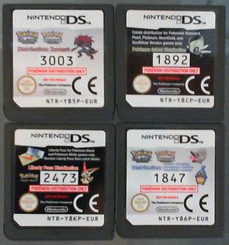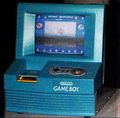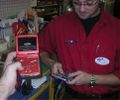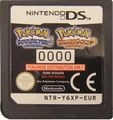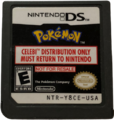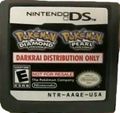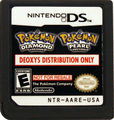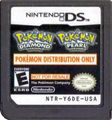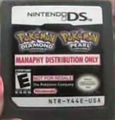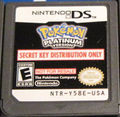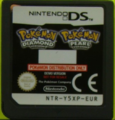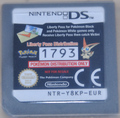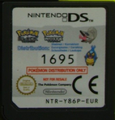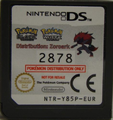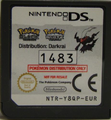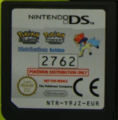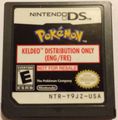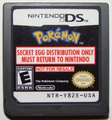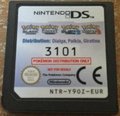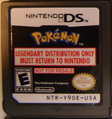Distribution device: Difference between revisions
(No need to embed these videos) Tag: Undo |
m (Link Pokémon Center New York) |
||
| (8 intermediate revisions by 3 users not shown) | |||
| Line 1: | Line 1: | ||
{{incomplete|2=Additional distribution methods}} | {{incomplete|2=Additional distribution methods}} | ||
[[File:Distribution cartridge various.jpg|thumb|right|Various distribution cartridges for Generations IV and V]] | [[File:Distribution cartridge various.jpg|thumb|right|Various distribution cartridges for Generations IV and V]] | ||
A '''distribution device''' is any device that is used to distribute [[event Pokémon|Pokémon events]]. | |||
Distribution devices include dedicated machines, regular Pokémon game cartridges, game cartridges with special software, and [[Nintendo GameCube]] discs with special software. They distribute events through a variety of methods, including directly plugging the cartridge into the device, [[Game Link Cable]]s, [[Game Boy Advance Wireless Adapter]]s, infrared, and local communication. | |||
==Pokémon machines== | |||
===Special machines=== | |||
The Special Machine (Japanese: '''特製マシン'''), sometimes referred to as a Mew Machine or a Celebi Machine, was used to distribute event Pokémon in [[Generation I]] starting with the {{DL|List of Japanese event Pokémon distributions (Generation I)|Nintendo Space World '97 Mew}} distribution. It was mainly used to distribute Mew but also other events like [[Surfing Pikachu]]. An updated version was used starting with the {{DL|List of Japanese event Pokémon distributions (Generation II)|Nintendo Space World 2000 Celebi}} for all {{p|Celebi}} events during [[Generation II]]. At separate events, Pokémon game cartridges containing event Pokémon downloaded from the special machines were sometimes used as "distribution cartridges", and the event Pokémon were exchanged via Game Link Cable. | |||
====Internal structure==== | |||
====Internal | |||
Video evidence shows that users of the distribution machine would insert their game cartridge into a slot on the front of the machine to initiate the download, which was then followed by a trade animation of the player receiving the event Pokémon. In 2021, actor Cody Burns interviewed ex-Nintendo representative Jeremy Hepworth on the 9th episode of the [https://www.youtube.com/watch?v=huiCsOIsHwg&list=PLbyXgDzUPi-fzbhKR8LUPZKicr9cMZj6b&index=9 Every Pokémon Ever] charity benefit. Hepworth stated that the internals of the machine had specially designed proprietary software that could transfer a Pokémon to a cartridge without the need to trade a Pokémon from the player. Rather, the player had to have an empty slot in their party for the download to initiate. When asked about the location of any existing machines, Hepworth stated that "If they do still exist, they're probably sitting around in a [Nintendo] storage unit somewhere... forgotten". As of 2023, the location of special Mew/Celebi distribution machines is still unknown. | Video evidence shows that users of the distribution machine would insert their game cartridge into a slot on the front of the machine to initiate the download, which was then followed by a trade animation of the player receiving the event Pokémon. In 2021, actor Cody Burns interviewed ex-Nintendo representative Jeremy Hepworth on the 9th episode of the [https://www.youtube.com/watch?v=huiCsOIsHwg&list=PLbyXgDzUPi-fzbhKR8LUPZKicr9cMZj6b&index=9 Every Pokémon Ever] charity benefit. Hepworth stated that the internals of the machine had specially designed proprietary software that could transfer a Pokémon to a cartridge without the need to trade a Pokémon from the player. Rather, the player had to have an empty slot in their party for the download to initiate. When asked about the location of any existing machines, Hepworth stated that "If they do still exist, they're probably sitting around in a [Nintendo] storage unit somewhere... forgotten". As of 2023, the location of special Mew/Celebi distribution machines is still unknown. | ||
| Line 17: | Line 16: | ||
Mew machine.jpg| Special machine for distributing {{DL|List of Japanese event Pokémon distributions (Generation I)|Nintendo Space World '99 Mew}} | Mew machine.jpg| Special machine for distributing {{DL|List of Japanese event Pokémon distributions (Generation I)|Nintendo Space World '99 Mew}} | ||
</gallery> | </gallery> | ||
====Generation II==== | ====Generation II==== | ||
<gallery> | <gallery> | ||
| Line 23: | Line 23: | ||
===Pokémon Distribution Machine=== | ===Pokémon Distribution Machine=== | ||
The Pokémon Distribution Machine (Japanese: '''ポケモン配布マシン''') also known as Pokémon Vending Machine was used to distribute campaign distributions in [[Generation II]] at [[ | The Pokémon Distribution Machine (Japanese: '''ポケモン配布マシン'''), also known as the Pokémon Vending Machine, was used to distribute campaign distributions in [[Generation II]] at [[Pokémon Center (store)|Pokémon Centers]] and debuted with the opening of the [[Pokémon Center New York]] for the distribution of the [[List of PCNY event Pokémon distributions (Generation II)|Gotta catch 'em all!]] campaigns. It was also used in Japanese Pokémon Centers to distribute the [[List of Japanese event Pokémon distributions (Generation II)#Pokémon Center Mystery Egg Campaigns|Mystery Egg]] campaigns. An updated version of the machine's software for [[Generation III]] was made in June, 2003 and used for the distribution of {{DL|List of Japanese event Pokémon distributions (Generation III)|Wishing Star Jirachi}} at the 18th World Hobby Fair and [[Pokémon Festa]] 2003 in Japan. In August, 2003 the machines from the Pokémon Center New York were updated for the distribution of the {{DL|List of PCNY event Pokémon distributions (Generation III)|Gotta Catch 'Em All campaigns in Generation III}}. The Pokémon Center New York machines were promoted as "Gotta Catch 'Em All Stations" and later succeeded by a different hardware setup promoted as the new Gotta Catch 'Em All Station which was used for the wireless [[Mystery Gift]] distribution of the {{DL|List of PCNY event Pokémon distributions (Generation III)|Wish Eggs}} campaign. | ||
The distribution machine was connected to a developer [[Gamecube]] and stored configurations, logs, and other information on a memory card. While | |||
The distribution machine was connected to a developer [[Gamecube]] and stored configurations, logs, and other information on a memory card. While Shiny Pokémon could be configured, this was never used in Generation III. The devices distribution could was used as the [[Trainer ID]] starting with 1. If more than 65535 Pokémon were distributed without restarting or powering off the device, then the ID would overflow to 0. | |||
====Generation II==== | ====Generation II==== | ||
<gallery> | <gallery> | ||
Gotta Catch 'Em All Station.jpg|[[New York | Gotta Catch 'Em All Station.jpg|[[Pokémon Center New York]]'s "Gotta Catch 'Em All Station" | ||
</gallery> | </gallery> | ||
==Distribution | ==Distribution cartridges== | ||
Game Link Cables were used to distribute many events until the start of [[Generation IV]]. Starting in [[Generation V]], infrared was used to distribute certain events in Japan and {{pmin|South Korea}}. | Game Link Cables were used to distribute many events until the start of [[Generation IV]]. Starting in [[Generation V]], infrared was used to distribute certain events in Japan and {{pmin|South Korea}}. | ||
| Line 42: | Line 43: | ||
Distribution system Generation I.jpg|Distribution system used for {{DL|List of European language event Pokémon distributions (Generation I)|U.S. Toys "R" Us Mew}} | Distribution system Generation I.jpg|Distribution system used for {{DL|List of European language event Pokémon distributions (Generation I)|U.S. Toys "R" Us Mew}} | ||
</gallery> | </gallery> | ||
===Generation III=== | ===Generation III=== | ||
<gallery> | <gallery> | ||
| Line 49: | Line 51: | ||
Distribution cartridge Generation III.jpg|Distribution system used in [[Generation III]] | Distribution cartridge Generation III.jpg|Distribution system used in [[Generation III]] | ||
</gallery> | </gallery> | ||
===Generation IV=== | ===Generation IV=== | ||
<gallery> | <gallery> | ||
| Line 68: | Line 71: | ||
Distribution cartridge Secret Key US.jpg|US {{si|Secret Key}} distribution DS card | Distribution cartridge Secret Key US.jpg|US {{si|Secret Key}} distribution DS card | ||
Distribution cartridge Shaymin EU.png|{{DL|List of local English event Pokémon distributions (Generation IV)|Movie 11 Shaymin}} distribution DS card | Distribution cartridge Shaymin EU.png|{{DL|List of local English event Pokémon distributions (Generation IV)|Movie 11 Shaymin}} distribution DS card | ||
Distribution cartridge Slot 2. | Distribution cartridge Slot 2.jpg|{{DL|List of local Japanese event Pokémon distributions (Generation IV)|10th Movie Deoxys}} distribution Slot 2 cartridge | ||
</gallery> | </gallery> | ||
===Generation V=== | ===Generation V=== | ||
<gallery> | <gallery> | ||
| Line 93: | Line 97: | ||
* [[Event Pokémon]] | * [[Event Pokémon]] | ||
{{-}} | |||
{{Project Games notice}} | {{Project Games notice}} | ||
Latest revision as of 09:23, 11 April 2024

|
This article is incomplete. Please feel free to edit this article to add missing information and complete it. Reason: Additional distribution methods |
A distribution device is any device that is used to distribute Pokémon events.
Distribution devices include dedicated machines, regular Pokémon game cartridges, game cartridges with special software, and Nintendo GameCube discs with special software. They distribute events through a variety of methods, including directly plugging the cartridge into the device, Game Link Cables, Game Boy Advance Wireless Adapters, infrared, and local communication.
Pokémon machines
Special machines
The Special Machine (Japanese: 特製マシン), sometimes referred to as a Mew Machine or a Celebi Machine, was used to distribute event Pokémon in Generation I starting with the Nintendo Space World '97 Mew distribution. It was mainly used to distribute Mew but also other events like Surfing Pikachu. An updated version was used starting with the Nintendo Space World 2000 Celebi for all Celebi events during Generation II. At separate events, Pokémon game cartridges containing event Pokémon downloaded from the special machines were sometimes used as "distribution cartridges", and the event Pokémon were exchanged via Game Link Cable.
Internal structure
Video evidence shows that users of the distribution machine would insert their game cartridge into a slot on the front of the machine to initiate the download, which was then followed by a trade animation of the player receiving the event Pokémon. In 2021, actor Cody Burns interviewed ex-Nintendo representative Jeremy Hepworth on the 9th episode of the Every Pokémon Ever charity benefit. Hepworth stated that the internals of the machine had specially designed proprietary software that could transfer a Pokémon to a cartridge without the need to trade a Pokémon from the player. Rather, the player had to have an empty slot in their party for the download to initiate. When asked about the location of any existing machines, Hepworth stated that "If they do still exist, they're probably sitting around in a [Nintendo] storage unit somewhere... forgotten". As of 2023, the location of special Mew/Celebi distribution machines is still unknown.
Generation I
Special machine for distributing Nintendo Space World '99 Mew
Generation II
Special machine for distributing Pokémon Fun Fest Celebi
Pokémon Distribution Machine
The Pokémon Distribution Machine (Japanese: ポケモン配布マシン), also known as the Pokémon Vending Machine, was used to distribute campaign distributions in Generation II at Pokémon Centers and debuted with the opening of the Pokémon Center New York for the distribution of the Gotta catch 'em all! campaigns. It was also used in Japanese Pokémon Centers to distribute the Mystery Egg campaigns. An updated version of the machine's software for Generation III was made in June, 2003 and used for the distribution of Wishing Star Jirachi at the 18th World Hobby Fair and Pokémon Festa 2003 in Japan. In August, 2003 the machines from the Pokémon Center New York were updated for the distribution of the Gotta Catch 'Em All campaigns in Generation III. The Pokémon Center New York machines were promoted as "Gotta Catch 'Em All Stations" and later succeeded by a different hardware setup promoted as the new Gotta Catch 'Em All Station which was used for the wireless Mystery Gift distribution of the Wish Eggs campaign.
The distribution machine was connected to a developer Gamecube and stored configurations, logs, and other information on a memory card. While Shiny Pokémon could be configured, this was never used in Generation III. The devices distribution could was used as the Trainer ID starting with 1. If more than 65535 Pokémon were distributed without restarting or powering off the device, then the ID would overflow to 0.
Generation II
Pokémon Center New York's "Gotta Catch 'Em All Station"
Distribution cartridges
Game Link Cables were used to distribute many events until the start of Generation IV. Starting in Generation V, infrared was used to distribute certain events in Japan and South Korea.
Distribution cartridges are given to stores for event distributions, and are not sold commercially. Starting in Generation IV, they only contain information for the event Pokémon, and have no actual game data or save possibilities. These cartridges use DS Wireless Communications to distribute events starting in Generation IV. At the end of an event, they are intended to be sent to Nintendo's Waste Management facility in Redmond, Washington, where they are presumably destroyed. However, sometimes, distribution cartridges are leaked or sold to the public.
No distribution cartridges are known to exist for event distributions for the post-Generation V games, presumably due to the advent of full digital games.
Generation I
Distribution system used for U.S. Toys "R" Us Mew
Generation III
Waiting for a distribution in Generation III
Distribution system used for the Top 10 Pokémon
Mystery Mew link trade distribution
Distribution system used in Generation III
Generation IV
Waiting for a distribution in Generation IV
Active distribution in Generation IV
Expired distribution in Generation IV
European Michina Arceus distribution DS card
Toys "R" Us Arceus distribution DS card
European Winter 2011 Celebi distribution DS card
Americas Winter 2011 Celebi distribution DS card
Toys "R" Us Darkrai distribution DS card
GameStop Deoxys distribution DS card
Toys "R" Us Dragonite distribution DS card
GameStop Pikachu-colored Pichu and GameStop Jirachi distribution DS card
GameStop legendary beasts (and undistributed Celebi) distribution DS card
Toys "R" Us Manaphy distribution DS card
Toys "R" Us Ash's Pikachu distribution DS card
US Secret Key distribution DS card
Movie 11 Shaymin distribution DS card
10th Movie Deoxys distribution Slot 2 cartridge
Generation V
Waiting for a distribution in Generation V
Active distribution in Generation V
Expired distribution in Generation V
European Liberty Ticket distribution cartridge
European Summer 2011 Karrablast and Summer 2011 Shelmet distribution cartridge
European Summer 2011 Zoroark distribution cartridge
US Zoroark Month Zoroark distribution cartridge
European Winter 2011 Darkrai distribution cartridge
European Summer 2012 Keldeo distribution cartridge
US Summer 2012 Keldeo distribution cartridge
European Spring 2013 Meloetta distribution cartridge
US Spring 2013 Meloetta distribution cartridge
US Secret Eggs distribution cartridge
European International Summer 2013 Pokémon of Myth trio distribution cartridge
United States Summer 2013 Shiny Pokémon of Myth distribution cartridge
See also

|
This game-related article is part of Project Games, a Bulbapedia project that aims to write comprehensive articles on the Pokémon games. |
